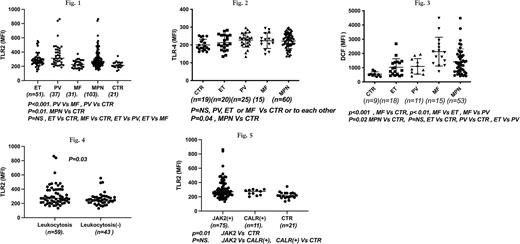Abstract
Introduction: Chronic inflammation and oxidative stress have been considered to be the hallmarks of MPNs for the last decade. Inflammatory cytokines have been reported to be increased in murine models and in patients samples. Increased ROS results from chronic inflammation in MPN has also been well described . There are still debates whether neoplastic clone or initial inflammation were the drivers of this inflammatory changes and carcinogenesis. We have previously studied Toll-like receptors (TLRs),a group of pattern recognition receptors (PRRs) which play critical roles in the host innate immune response and in the pathogenesis of a variety of acute and chronic inflammatory conditions and carcinogenesis , and we found TLR-2 were the predominant TLR derangements in MPN ( Blood (2015) 126 (23): 5202). We now extend our studies to involve more patients and correlated TLR-2 with the other clinical features .
Materials and Methods: 103 patients with MPN diseases (19 PMF, 6 post-PV-MF, 6 post-ET-MF, 51 ET, 37 PV, and 21 normal volunteer controls) were enrolled in the study. 1) TLR-2, 4quantifications were performed by immuno-staining of 1×106mononuclear cells that were incubated with fluorescence-conjugated anti-TLR-2,3, 4, 7, and 9 antibodies and assayed by flow cytometry. 2) Cell ROS ( reactive oxygen species) measurement. Cellular ROS was determined by a dichlorofluorescein (DCF) assay. PBMNCs were incubated with 10 μM 2′,7′ ichlorodihydrofluorescein diacetate (carboxy-H2DCFDA) (Life Technologies) for 30 min at 37°C. The oxidation of H2DCFDA was measured and analyzed by flow cytometry.
Results. Fig1. TLR-2 levels were significantly elevated in PV and MPN ( grouped PV , ET and MF) , while PV were significantly elevated than MF or controls and not with ET ; ET were not significantly different from MF or controls . Fig 2,TLR-4 were not significantly elevated in PV, ET or MF than controls but were elevated when they were grouped as MPN , Fig 3. MF has significantly elevated cellular ROS than PV , ET or controls while PV, ET were not different from controls and when they were grouped together as MPN , were significantly elevated than controls . Fig 4. TLR-2 were correlated to leukocytosis in MPN patients but not with anemia or thrombocytosis . Fig5, TLR2 were significantly elevated in Jak2 V617F mutation positive than controls and were more elevated than CALR mutation patients .
Conclusion. From these studies , we can conclude that 1) TLR-2 were the most predominant elevated TLR in MPN patients 2) PV has significantly more elevated TLR-2 than MF or controls but not ET, and ROS were significantly elevated in MF than ET or PV , suggesting that initial inflammation was initiated by TLR2 pathway in PV or ET and then after years of chronic inflammationled to accumulation of more ROS resulting in MF transformation and JAK2 mutation, thus favoring the theory that MPN was initiated first by inflammatory response then the neoplastic clone . 3) TLR2 were more significantly elevated in JAK2 mutation and leukocytosis , and appear to be more elevated in Jak2 mutation than CALR mutation positive patients ( though not statistically significant, probably the number of patients were not enough) ; this corresponded to the clinical observation that JAK2 mutation positive status has more thrombosis than CALR mutations and correlated to leukocytosis .
Disclosures
No relevant conflicts of interest to declare.
Author notes
Asterisk with author names denotes non-ASH members.


This feature is available to Subscribers Only
Sign In or Create an Account Close Modal